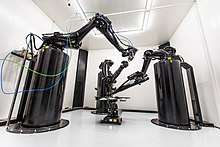Relativity Space
Relativity Space is a private American aerospace manufacturer company headquartered in Los Angeles, California. It was founded in 2015 by Tim Ellis and Jordan Noone.[3] Relativity is developing its own launchers and rocket engines for commercial orbital launch services.
 | |
| Commercial orbital launch services | |
| Industry | Aerospace manufacturer |
| Fate | Active |
| Founded | 2015 [1] |
| Founders | Tim Ellis (CEO) and Jordan Noone |
| Headquarters | Los Angeles, California , United States |
| Products | Terran 1 rocket |
Number of employees | 165 [2] (2020) |
| Website | https://www.relativityspace.com/ |
History
Relativity Space was founded on the idea that Blue Origin and SpaceX were not doing enough to use 3D printing as part of rocket manufacturing. Relativity plans to 3D print an entire launch vehicle they call Terran 1. The extensive use of 3D printing has allowed the company to iterate designs quickly, use less tooling and human labor. In March 2018, Relativity Space signed a 20-year lease at the John C. Stennis Space Center, a NASA rocket testing facility, to test engine components and eventually test full-scale Aeon 1 rocket engines.[3][4] Relativity announced on 17 January 2019 that it won a competitive bidding process with the United States Air Force to build and operate Launch Complex 16 (LC-16) at Cape Canaveral. The company recently announced its Series C funding, bringing the total funding amount to US$185.7 million.[5] Relativity is privately funded by Bond, Tribe Capital, Playground Global, Social Capital, Y Combinator, and Mark Cuban. The company says it will launch its first rocket named Terran 1 from the site in late 2020.[6] Relativity plans to start commercial launch service by early 2021.[4]
Relativity Space, aiming to fly its orbital rocket from Cape Canaveral for the first time next year, announced on 24 June 2020, it has signed a contract with Iridium for up to six launches of the company's spare communications satellites. Relativity also announced it plans to develop a second launch pad at Vandenberg Air Force Base to allow for missions to polar orbits, including the launches carrying Iridium satellites, between 2023 and 2030.[7]
3D-printing
In order to 3D print large components, Relativity has created a system named Stargate which it claims is the world's largest 3D printer of metals.[8][9] The system is based on selective laser sintering,[9] which uses laser beams to bond powdered metal, layer by layer, into precise and complex structures that have minimal parts. The company aims at 3D-printing at least 95% of their launcher, including the engines, by the end of 2020.[9] The company plans to eventually 3D-print a complete launch vehicle within 60 days.[10][4]
Aeon 1 rocket engine
The Aeon 1 rocket engine first stage is designed to create 15,500 pounds of thrust (68975 newtons of force) at sea level and 25,400 pounds of thrust (86775 newtons) in a vacuum. The engine is powered by liquid natural gas and liquid oxygen (LOX). It is made out of a proprietary 3D-printed alloy. It is 3D-printed and assembled from less than 1000 parts.[11] Relativity has completed more than 300 test firings of the Aeon 1 engine, using the E-3 facility at NASA's John C. Stennis Space Center in Mississippi.[4]
Terran 1 launch vehicle
The Terran 1 is an expendable launch vehicle under development that will consist of two stages. The first stage will use 9 Aeon 1 engines, while the second stage will use a single Aeon 1 engine. The maximum payload will be 1,250 kilograms (2,760 lb) to 185 km low Earth orbit, normal payload 900 kilograms (2,000 lb) to 500 km SSO sun-synchronous orbit, high-altitude payload 700 kilograms (1,500 lb) to 1200 km SSO. The rocket will not use helium for pressure but will use autogenous pressurization.[12] Relativity's advertised launch price of US$12 million per Terran 1 mission.[7]
See also
- NewSpace
- List of private spaceflight companies – Wikipedia list article
- Rocket Lab – U.S. launch vehicle manufacturer
- Firefly Aerospace – A private aerospace firm based in US.
- PLD Space – A private Spanish launch services provider
References
- "Accelerating the future of space, faster". Relativity Space. Retrieved 9 June 2019.
- Sheetz, Michael (12 May 2020). "Space start-up Relativity verified its 3D printing process works to build a rocket". CNBC. Retrieved 31 May 2020.
- Eric Berger (21 March 2018). "Relativity Space reveals its ambitions with big NASA deal". Ars Technica. Retrieved 25 March 2018.
- Sheetz, Michael (27 March 2018). "A start-up that manufactures rockets with giant 3-D printers just scored $35 million in funding". CNBC. Retrieved 9 June 2019.
- "Relativity Space". Crunchbase. Retrieved 21 October 2019.
- Knapp, Alex (17 January 2019). "Under 30 Startup Relativity Space Will Be Launching From Cape Canaveral". Forbes. Retrieved 9 June 2019.
- "Relativity books up to six launches for Iridium, reveals plans for Vandenberg pad". Spaceflight Now. 24 June 2020. Retrieved 24 June 2020.
- Jeff Foust (5 December 2017). "Relativity Space aims to 3D print entire launch vehicles". SpaceNews. Retrieved 25 March 2018.
- Mosher, Dave (22 October 2018). "Defectors from SpaceX, Blue Origin, and Tesla are developing a remarkable technology called 'Stargate' to help colonize other planets". Business Insider. Retrieved 9 June 2019.
- Johnson, Jennifer (16 May 2018). "Rocket Plan: How 3-D Printing Is Unlocking A New Space Race". Forbes. Retrieved 9 June 2019.
- TMRO:Space - Relativity: How to print a rocket on Earth and Mars - Orbit 11.19 on YouTube
- "Terran". Relativity Space. Retrieved 20 January 2019.